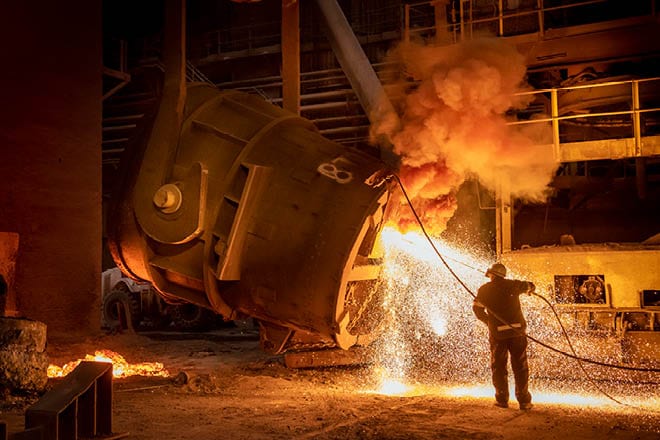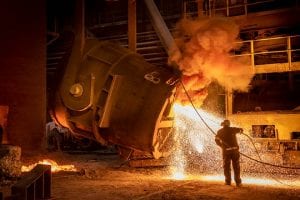Why we own one of the most carbon intensive stocks in our investment universe
John Bennett and Tom O'Hara, European equities portfolio managers, explain why investing in so-called high ESG risk companies can prove to be beneficial as an active manager.

5 minute read
Key takeaways:
- ‘ESG by avoidance’ often fails to recognise the importance of scrutinising companies which may have exposure to high levels of carbon, such as steelmaking. Instead, the managers believe that holding these companies to account is more constructive.
- The European Union’s proposed ‘carbon border adjustment’ could transform margin volatility in Europe by placing high levies on imported steel and drive a sustainable supply/demand dynamic.
- This change could impact both the ESG status and financials of the steel industry.
The steel industry has been a poor area in which to invest for over a decade with low margins, volatile earnings, chronic oversupply, cyclical demand and high carbon output. ArcelorMittal is classified as one of the most carbon intensive stock in our investment universe and Sustainalytics, an independent provider of environmental, social and governance (ESG) research and ratings, attributes an ESG risk rating of 37.7 (High Risk) to the company. So how can an investor who believes in a clear link between the cost of capital of an equity and its associated ESG risks consider such an investment for their portfolios? The answer, as is true of many of our investments, is to invest in change.
We believe that ‘ESG by avoidance’ (simply excluding high carbon stocks and industries) will increasingly look like an outdated and potentially suboptimal investment approach as it closes its eyes to the complex challenges at hand. If high carbon industries fail to gain funding from public markets they will increasingly seek private funding, where environmental scrutiny may be much lower. Instead we seek to apply our clients’ capital to those areas and companies which present a credible decarbonisation strategy, and hold them to their timeline and targets. We believe this will have a greater environmental impact in the long term, rather than exclusively offering our clients’ capital to companies that are dubbed ‘environmental winners’ simply as a result of their asset light business models.
ArcelorMittal’s path to decarbonisation
Steel is one of the most recyclable materials on earth but scrap availability cannot meet society’s yearly additions to the capital stock of steel, which is intensified by emerging market infrastructure development and the shift to steel-intensive renewable power generation. Steelmaking therefore continues to rely heavily on the conversion of iron ore, a very carbon intensive process. To illustrate, a 2011 Carbon Trust study revealed that in the UK each tonne of steel produced from iron ore generates on average around 2.3 tonnes of CO2 due to the energy required in the process.
- smart carbon – includes technologies such as carbon capture, storage and reuse and the replacement of coking coal with bioenergy sources
- green hydrogen – hydrogen from renewable energy sources used in the direct reduced iron (DRI) process.
The cost implications of these are enormous – firstly, to convert steelmaking sites, but more importantly, to establish the shared clean energy infrastructure in society that will be required to decarbonise steel, cement, heating, transport and other sources of emissions.
The European Union (EU) recognises the need for policy support to enable this complex transition and to create global decarbonisation leaders across all industries. Policymakers in the EU are looking at the prospect of a ‘carbon border adjustment’ for steel and cement, which should become established through 2021.
A steel carbon border adjustment scenario
An EU-based company imports a tonne of steel from a country that does not have an established carbon pricing mechanism such as the EU’s emissions trading system (ETS). The producer of that imported steel is at a cost advantage compared to domestic EU steelmakers who have to pay for their emissions. This is known as ‘carbon leakage’ and risks undermining the profitability of the EU’s steel industry and preventing investment in decarbonisation technologies.

Under the new system, if a tonne of steel produced creates two tonnes of CO2, the imported tonne of steel will be subject to a levy of two times the carbon price. At a carbon price of EUR40/tonne (t), the imported tonne of steel would incur a levy of EUR80/t.*
European steel prices have averaged EUR600/t over the last decade with low and volatile EBITDA per tonne margins of around EUR25-75/t. Cheap imports, with no carbon cost incurred domestically or at the point of import, have been a major driver of the financial weakness of the industry.
Accounting for carbon could reverse the EU steel industry’s economic erosion from cheap imports over the last decade, transforming margin volatility and the industry’s ability to invest in decarbonisation.
China is also looking at its steel policy
Over the last decade, China has been the main exporter of cheap steel. However, the country is now taking action to rationalise its domestic steel industry with a series of initiatives to tackle the most polluting capacity and to make it less worthwhile to export steel. China is rightly questioning the value of producing over two tonnes of carbon locally just to export one tonne of steel, which often makes little profit. A reduction in China steel exports is another major driver for a more sustainable supply/demand dynamic in the steel industry and its ability to invest in decarbonisation. This change could affect both the ESG status and financials of the steel industry.
*desk estimations, as at May 2021.
EBITDA: Earnings before income, tax, depreciation and amortisation.
These are the views of the author at the time of publication and may differ from the views of other individuals/teams at Janus Henderson Investors. References made to individual securities do not constitute a recommendation to buy, sell or hold any security, investment strategy or market sector, and should not be assumed to be profitable. Janus Henderson Investors, its affiliated advisor, or its employees, may have a position in the securities mentioned.
Past performance does not predict future returns. The value of an investment and the income from it can fall as well as rise and you may not get back the amount originally invested.
The information in this article does not qualify as an investment recommendation.
Marketing Communication.
Important information
Please read the following important information regarding funds related to this article.
- Shares/Units can lose value rapidly, and typically involve higher risks than bonds or money market instruments. The value of your investment may fall as a result.
- Shares of small and mid-size companies can be more volatile than shares of larger companies, and at times it may be difficult to value or to sell shares at desired times and prices, increasing the risk of losses.
- If a Fund has a high exposure to a particular country or geographical region it carries a higher level of risk than a Fund which is more broadly diversified.
- This Fund may have a particularly concentrated portfolio relative to its investment universe or other funds in its sector. An adverse event impacting even a small number of holdings could create significant volatility or losses for the Fund.
- The Fund may use derivatives with the aim of reducing risk or managing the portfolio more efficiently. However this introduces other risks, in particular, that a derivative counterparty may not meet its contractual obligations.
- If the Fund holds assets in currencies other than the base currency of the Fund, or you invest in a share/unit class of a different currency to the Fund (unless hedged, i.e. mitigated by taking an offsetting position in a related security), the value of your investment may be impacted by changes in exchange rates.
- When the Fund, or a share/unit class, seeks to mitigate exchange rate movements of a currency relative to the base currency (hedge), the hedging strategy itself may positively or negatively impact the value of the Fund due to differences in short-term interest rates between the currencies.
- Securities within the Fund could become hard to value or to sell at a desired time and price, especially in extreme market conditions when asset prices may be falling, increasing the risk of investment losses.
- The Fund could lose money if a counterparty with which the Fund trades becomes unwilling or unable to meet its obligations, or as a result of failure or delay in operational processes or the failure of a third party provider.
Specific risks
- Shares/Units can lose value rapidly, and typically involve higher risks than bonds or money market instruments. The value of your investment may fall as a result.
- Shares of small and mid-size companies can be more volatile than shares of larger companies, and at times it may be difficult to value or to sell shares at desired times and prices, increasing the risk of losses.
- If a Fund has a high exposure to a particular country or geographical region it carries a higher level of risk than a Fund which is more broadly diversified.
- The Fund may use derivatives with the aim of reducing risk or managing the portfolio more efficiently. However this introduces other risks, in particular, that a derivative counterparty may not meet its contractual obligations.
- If the Fund holds assets in currencies other than the base currency of the Fund, or you invest in a share/unit class of a different currency to the Fund (unless hedged, i.e. mitigated by taking an offsetting position in a related security), the value of your investment may be impacted by changes in exchange rates.
- When the Fund, or a share/unit class, seeks to mitigate exchange rate movements of a currency relative to the base currency (hedge), the hedging strategy itself may positively or negatively impact the value of the Fund due to differences in short-term interest rates between the currencies.
- Securities within the Fund could become hard to value or to sell at a desired time and price, especially in extreme market conditions when asset prices may be falling, increasing the risk of investment losses.
- The Fund could lose money if a counterparty with which the Fund trades becomes unwilling or unable to meet its obligations, or as a result of failure or delay in operational processes or the failure of a third party provider.

